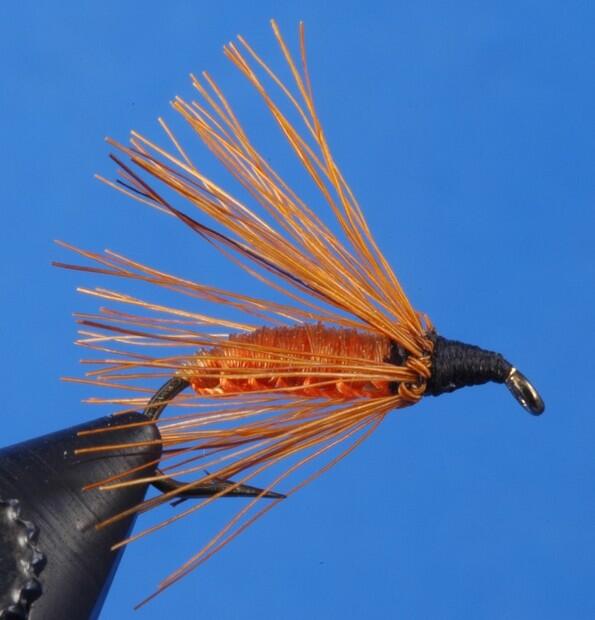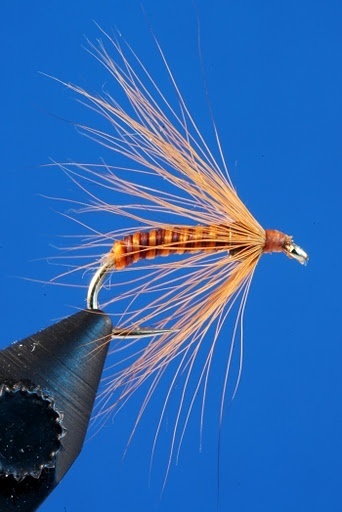Hair Hackle Wet Flies
Franz B. Pott was a Missoula Montana wig maker and fly tier/fly fisherman who started making woven hair flies near the start of the 20th century. For nearly fifty years his flies were the most popular and best selling flies in the state. His most popular fly was the

for nearly a half a century: $0.35 each or three for a dollar. In the early days this was a lot. Montana fly fishermen grumbled about the exorbitant price, but paid it anyway. Later on, when $0.35 each made them the cheapest flies you could buy, they gradually fell into disfavor. Perhaps they should have raised the price. Stuff that costs a lot seems to sell well these days. Henry Wombacher, George Grant and Mike Wilkerson 2 kept the woven hair hackled wet fly tradition alive for another two or three decades after Pott's death in 1956.
The Art of Weaving Hair Hackles
George Grant has a lot to say about soft feather hackled wet flies being inappropriate for large freestone Montana Rivers. I find it hard to go along with that. Soft Hackle wet flies are indispensable standards now, in just about everybody's fly box, including my own. But soft hackles are better suited to small flies: sizes 14-22.

For size 10-14 meat and potatoes wet flies, Hair Hackle wet flies are hard to beat. Ninety or more years of Montana fly fishing history have already proven that much. So I think George Grant just missed the point. It's not that Soft Hackle wet flies are no good. They are. But so are Hair Hackle wet flies. You need them both. Despite their long history of success, however, Hair Hackle wet flies are all but forgotten now. The reason--I think--is the difficulty in making them. Franz Pott was a wig maker who knew how to knot small clumps of hair together. And he did what he knew how to do. His woven Hair Hackle wet flies were so successful they became everybody's Montana goto fly for the better part of a century. Writhing, wiggling, splashing success on then end of your line is hard to argue with. But woven hair hackle flies were and still are devilishly time consuming and hard to make. George Grant went to great lengths to justify that effort: "Every fly-tyer is aware of the difficulty of securing coarse hair to the shank of the hook by successive bindings of thread. If the hair is course and stiff, as it should be for Western flies, it does not buckle under pressure and remains too flat against the fly body instead of flaring," George wrote. George goes on to wield this and other arguments in favor of weaving hair hackles before winding the fly. Be that as it may, manual hackle weaving is gone forever now. Perhaps some machine weaving process will someday emerge. But in its automated absense, woven Hair Hackle wet flies will never be much more than a beautiful and effective but too-hard-to-make historical curiosity. I thought there might be a way to resurrect these wonderful old flies. If I could somehow tie these flies without building a loom and learning how to tie wig-makers knots, there might just be a way to do it. And as it turns out, there is indeed a quick and dirty way to make these flies, without weaving anything. I put a metal bead at the front end of the abdomen and then twist on a simple, un-woven hair collar. After tying on the hair hackle, winding the tying thread up close to the bead forces the hair to flare out properly. The visual difference between my imitations and the real thing is negligable. The tying time difference is enormous. While using beads is indeed the easiest method, it's even possible to make unweighted hair hackle wet flies, still without weaving. To do that, well, you'll just have to follow the links. These Hair Hackle wet flies are among the most powerful flies I know. I fish them almost constantly now.
Notes:
1 From George Grant's audio cassette tape: Franz Pott: A Matter of Loyalty
2 Mike Wilkerson--the last owner/operator of the Pott Fly Company--stopped manufacturing the Pott flies a little less than ten years ago. Mike's generosity made this website's extensive